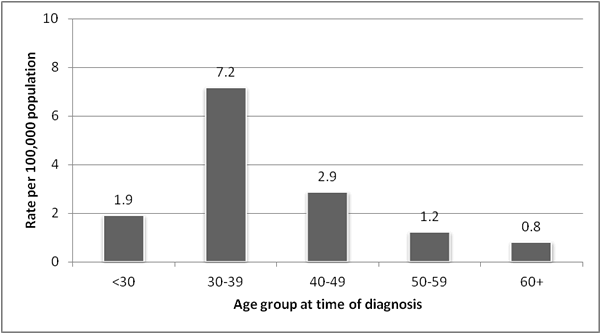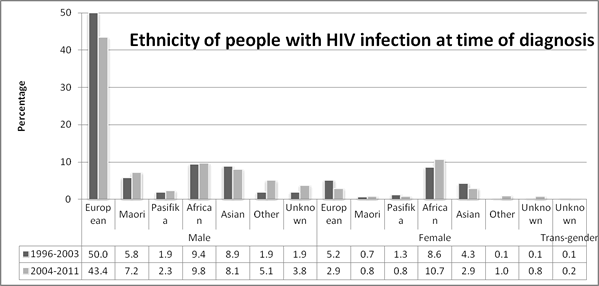Indicator 36: HIV/AIDs statistics
| Indicator is fully reported? | Older people with HIV/AIDS are included in statistics. Information about caregivers is not collected. |
| Type of indicator |  Instrumental indicator Instrumental indicator |
| Other relevant indicators |
Core indicators for Global AIDS Response Progress Reporting have been prepared and our country’s response for 2011/12 is published at www.health.govt.nz.[1] Several indicators focus on people 49 years old or younger but others do not exclude older people. The Ministry of Health worked with relevant groups to prepare the report. |
| Our findings |
Since 1985, 3689 people have been diagnosed with HIV infection. Some information about people with HIV/AIDS is available by age, gender, and ethnicity. Data about HIV/AIDS is published twice a year in newsletters prepared by the AIDS Epidemiology Unit, Dunedin School of Medicine, University of Otago.[2] Age: Information about the infected person’s age is obtained at the time of diagnosis. The Ministry of Health calculated for us the rate of new infections per 100,000 population by age group for a single 12-month period for the year ending 30 September 2012 (see Figure 1). The rate for people aged 60+ was 0.8 (representing about four or five people) compared to a rate of 7.2 for 30-39 year olds. Gender: Information about the infected person’s gender is obtained at the time of diagnosis. Of the people diagnosed with HIV/AIDS since 1985, about 82% were male and about 17% were female. The other 1% were trans-gender or their gender was unknown. Ethnicity: Information about the infected person’s ethnicity is obtained at the time of diagnosis. The number of people whose ethnicity is unknown is large enough to alter the trends that are shown for everyone except European men (see Figure 2). This means that care needs to be taken when considering this information. |
| How entities use the data |
Data is used for health promotion, to provide peer support, to provide care and treatment, and to identify emerging issues. HIV/AIDS is not a significant health indicator for people aged 60+. |
| Entity responsible for this indicator |
Ministry of Health (lead) |
Figure 1: Rate of new HIV/AIDS infection per 100,000 population for the year ending 30 September 2012, by age group

Source: Ministry of Health – using data provided to it by the AIDS Epidemiology Group and estimated population data from Statistics New Zealand.
Figure 2: Ethnicity of people with HIV infection at time of diagnosis, 1996-2011

Source: AIDS Epidemiology Group (October 2012), AIDS – NEW ZEALAND, Issue 70, Table 3.
[1] Ministry of Health (March 2012), Country progress report New Zealand, Reporting Period: January 2010 – December 2011, www.health.govt.nz.
[2] The newsletters are published at http://dnmeds.otago.ac.nz/departments/psm/research/aids/newsletters.html and www.health.govt.nz.

